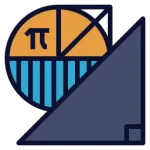Library Function acosh in Math Class
Library Function acosh of math.h Header File in C
On this page we will discuss about library function acosh in math class which is used in C.The C header file math.h contains the standard math library functions that can be used for performing various mathematical operations. The acosh function returns the arc hyperbolic cosine of x in radians.

Library Function acosh of math.h Header File
- In C programming language the acosh function is included in math.h header file.
- The acosh function takes input argument in the range of (x\geq 1) and returns the inverse hyperbolic cosine of parameter x in radians.
acosh(x) = \cosh^{-1}(x)
Declaration of acosh function
double acosh(double x)
int x = 0; double result; result = acosh(double(x));
Parameters of acosh function
The acosh function accepts a single input value which is greater than or equal to 1.
| Parameter | Description |
|---|---|
| double value | This value of double function is greater than or equal to 1(x\geq 1). |
Return value of acosh function
The acosh function returns a value or a number which is greater than or equal to 0 in radians. The function returns NaN if the parameter passed to acosh function is less than 1.
| Parameter | Return Value |
|---|---|
| x\geq 1 | It returns a number greater than or equal to 0 in radians |
| x>1 or x<-1 | NaN (not a number) |
Implementation of Library Function math.h acosh
Example 1:
The following code shows the use of acosh function with different parameters passed to the function.
#include <stdio.h>
#include <math.h>
int main()
{
// constant PI is defined
const double PI = 3.1415926;
double y, return_value_of_function;
y = 6.8;
return_value_of_function = acosh(y);
printf("Value of acosh(%.2f) function = %.2lf in radians\n", y, return_value_of_function);
// converting radians to degree
return_value_of_function = acosh(y)*180/PI;
printf("Value of acosh(%.2f) function = %.2lf in degrees\n", y, return_value_of_function);
// parameter not in range
y = 0.7;
return_value_of_function = acosh(y);
printf("Value of acosh(%.2f) function = %.2lf", y, return_value_of_function);
return 0;
}
Output:
Value of acosh(6.80) function = 2.60 in radians Value of acosh(6.80) function = 149.23 in degrees Value of acosh(0.70) function = -nan
Example 2:
The following code shows the use of acosh function when parameters such as INFINITY and DBL_MAX are passed to the function.
#include <stdio.h>
#include <math.h>
#include <float.h>
int main()
{
double y, return_value_of_function;
// maximum representable finite floating-point number
y = DBL_MAX;
return_value_of_function = acosh(y);
printf("Maximum value of acosh() function in radians = %.3lf\n", return_value_of_function);
// Infinity
y = INFINITY;
return_value_of_function = acosh(y);
printf("When infinity is passed to acosh() function, return_value = %.3lf\n", return_value_of_function);
return 0;
}
Output:
Maximum value of acosh() function in radians = 710.476 When infinity is passed to acosh() function, return_value = inf
Also, math.h header file is included to use INFINITY parameter in our program which is a constant expression representing positive infinity.
Prime Course Trailer
Related Banners
Get PrepInsta Prime & get Access to all 200+ courses offered by PrepInsta in One Subscription
Get over 200+ course One Subscription
Courses like AI/ML, Cloud Computing, Ethical Hacking, C, C++, Java, Python, DSA (All Languages), Competitive Coding (All Languages), TCS, Infosys, Wipro, Amazon, DBMS, SQL and others






Login/Signup to comment